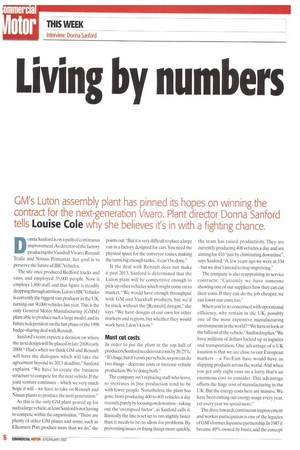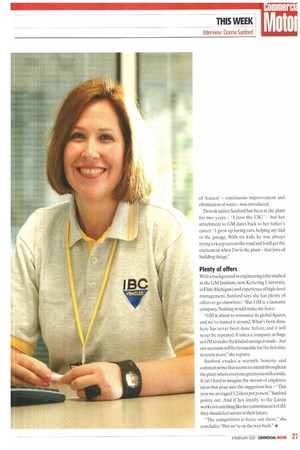Living by numbers
Page 26

Page 27

If you've noticed an error in this article please click here to report it so we can fix it.
GM's Luton assembly plant has pinned its hopes on winning the contract for the next-generation Vivaro. Plant director Donna Sanford
tells Louise Cole why she believes it's in with a fighting chance.
Donna Sanford is on a path of continuous improvement.As director of the factory producing the Vauxhall Vivaro, Renault Trafic and Nissan Primastar, her goal is to preserve the future of IBC Vehicles.
The site once produced Bedford trucks and vans, and employed 35,000 people. Now it employs 1,800 staff, and that figure is steadily dropping through attrition. Luton's IBC Vehicles is currently the biggest van producer in the UK, turning out 90,000 vehicles last year. This is the only General Motor Manufacturing (GMM) plant able to produce such a large model, and its future is dependent on the last phase of the 1998 badge-sharing deal with Renault.
Sanford's team expects a decision on where the next design will be placed in late 2008/early 2009, "That's when we think GM and Renault will have the dialogues which will take the agreement beyond its 2013 deadline," Sanford explains. We have to create the business structure to compete for the next vehicle. If the joint venture continues — which we very much hope it will — we have to take on Renault and Nissan plants to produce the next generation."
As this is the only GM plant geared up for such a large vehicle,at least Sanford is not having to compete within the organisation. "There are plenty of other GM plants and some, such as Ellesmere Port, produce more than we do," she points out."But it is very difficult to place a large van in a factory designed for cars. You need the physical space for the conveyor routes, making the turns, big enough tanks... it can't be done."
If the deal with Renault does not make it past 2013, Sanford is determined that the Luton plant will be competitive enough to pick up other vehicles which might come on to market. "We would have enough throughput with GM and Vauxhall products, but we'd be stuck without the [Renault] designs," she says. "We have designs of our own for other markets and regions, but whether they would work here, I don't know."
Must cut Costs In order to put the plant in the top half of producers, Sanford needs to cut costs by 20-25%: -It's huge,but it's costs per vehicle, so you can do two things — decrease costs or increase vehicle production. We're doing both."
The company isn't replacing staff who leave, so increases in line production tend to be with fewer people. Nonetheless, the plant has gone from producing 400 to 405 vehicles a day recently,purely by focusing on downtime —taking out the `overspeed factor', as Sanford calls it. Basically the line is set up to run slightly faster than it needs to be, to allow for problems. By preventing issues or fixing things more quickly, the team has raised productivity. They are currently producing 408 vehicles a day and are aiming for 410 "just by eliminating downtime", says Sanford: "A few years ago we were at 334 —but we don't intend to stop improving."
The company is also reappraising its service contracts: "Currently we have someone showing one of our suppliers how they can cut their costs. If they can do the job cheaper, we can lower our costs,too."
When you're so concerned with operational efficiency, why remain in the UK, possibly one of the most expensive manufacturing environments in the world? "We have to look at the full cost of the vehicle," Sanford replies."We have millions of dollars locked up in logistics and transportation. One advantage of a UK location is that we are close to our European markets — a Far-East base would have us shipping products across the world. And when you get only eight vans on a lorry, that's an enormous cost to consider. This advantage offsets the huge cost of manufacturing in the UK. But the energy costs here are massive. We have been cutting our energy usage every year, yet every year we spend more."
The drive towards continuous improvement and worker participation is one of the legacies of GM's former Japanese partnership. In 1987 it became 40% owned by Isuzu, and the concept of 'kaizen' — continuous improvement and elimination of waste— was introduced.
Detroit native Sanford has been at the plant for two years — "I love the UK!" — but her attachment to GM dates back to her father's career: "I grew up loving cars, helping my dad in the garage. With six kids, he was always trying to keep cars on the road and I still get the excitement when I'm in the plant — that love of building things"
Plenty of offers
With a background in engineering (she studied at the GM Institute, now Kettering University. in Flint,Michigan) and experience of high-level management. Sanford says she has plenty of offers to go elsewhere: But GM is a fantastic company. Nothing would make me leave.
"GM is about to announce its global figures, and we've turned it around. What's been done here has never been done before, and it will never be repeated. Ti takes a company as huge as GM to make the kind of savings it made—hut our accounts vvi H be favourable for the first time in seven years." she reports.
Sanford exudes a warmth, honesty and commonsense that seems to extend throughout the plant.where everyone greets you with a smile. It isn't hard to imagine the stream of employee ideas that pour into the suggestion box —"This year we averaged 5.2 ideas per person," Sanford points out. And if her loyalty to the Luton workers is anything like her commitment to GM, they should feel secure in their future.
"The competition is fierce out there," she concludes."But we're on the way back." •


























































































































































































